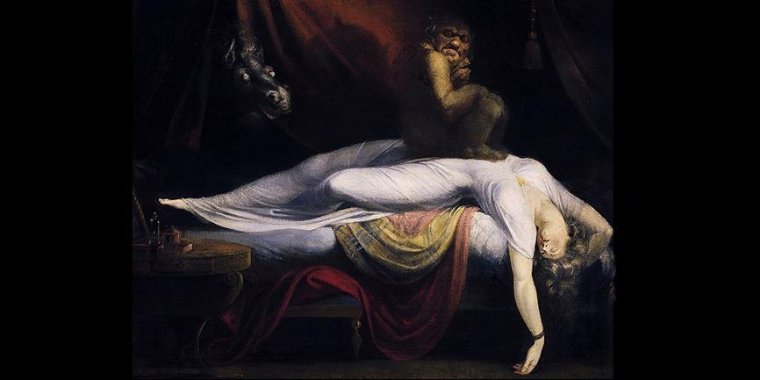| Health / Health News |
Meditation-relaxation therapy may offer escape from the terror of sleep paralysis
Sleep paralysis – a condition thought to explain a number of mysterious experiences including alleged cases of alien abduction and demonic night-time visits – could be treated using a technique of meditation-relaxation, suggests a pilot study published today.

The Nightmare by Henry Fuseli, 1781. Photo: Wikipedia
Sleep paralysis is a state involving paralysis of the skeletal muscles that occurs at the onset of sleep or just before waking. While temporarily immobilised, the individual is acutely aware of their surroundings.
People who experience the phenomenon often report being terrorised by dangerous bedroom intruders, often reaching for supernatural explanations such as ghosts, demons and even alien abduction. Unsurprisingly, it can be a terrifying experience.
As many as one in five people experiences sleep paralysis, which may be triggered by sleep deprivation, and is more frequent in psychiatric conditions like post-traumatic stress disorder. It is also common in narcolepsy, a sleep disorder involving excessive daytime sleepiness and sudden loss of muscle control.
a team of researchers report a pilot study of meditation-relaxation therapy involving 10 patients with narcolepsy, all of whom experience sleep paralysis.
The therapy was originally developed by Dr Baland Jalal from the Department of Psychiatry, University of Cambridge. The current study was led by Dr Jalal and conducted in collaboration with Dr Giuseppe Plazzi’s group at the Department of Biomedical and Neuromotor Sciences, University of Bologna/IRCCS Istituto delle Scienze Neurologiche di Bologna, Italy.
The therapy teaches patients to follow four steps during an episode:
• Reappraisal of the meaning of the attack – reminding themselves that the experience is common, benign, and temporary, and that the hallucinations are a typical by-product of dreaming.
• Psychological and emotional distancing – reminding themselves that there is no reason to be afraid or worried and that fear and worry will only make the episode worse.
• Inward focused-attention meditation - focusing their attention inward on an emotionally-involving, positive object (such as a memory of a loved one or event, a hymn/prayer, God).
• Muscle relaxation – relaxing their muscles, avoiding controlling their breathing and under no circumstances attempting to move.
Participants were instructed to keep a daily journal for four weeks to assess sleep paralysis occurrence, duration and emotions. Overall, among the 10 patients, two-thirds of cases (66%) reported hallucinations, often upon awakening from sleep (51%), and less frequently upon falling asleep (14%) as rated during the first four weeks.
After the four weeks, six participants completed mood/anxiety questionnaires and were taught the therapy techniques and instructed to rehearse these during ordinary wakefulness, twice a week for 15 min. The treatment lasted eight weeks.
In the first four weeks of the study, participants in the meditation-relaxation group experienced sleep paralysis on average 14 times over 11 days. The reported disturbance caused by their sleep paralysis hallucinations was 7.3 (rated on a ten-point scale with higher scores indicating greater severity).
In the final month of the therapy, the number of days with sleep paralysis fell to 5.5 (down 50%) and the total number of episodes fell to 6.5 (down 54%). There was also a notable tendency towards reductions in the disturbance caused by hallucinations with ratings dropping from 7.3 to 4.8.
A control group of four participants followed the same procedure, except participants engaged in deep breathing instead of the therapy – taking slow deep breaths, while repeatedly counting from one to ten.
In the control group, the number of days with sleep paralysis (4.3 per month at the start) was unchanged, as well as their total number of episodes (4.5 per month initially). The disturbance caused by hallucinations was likewise unchanged (rated 4 during the first four weeks).
If the researchers are able to replicate their findings in a larger number of people – including those from the general population, not affected by narcolepsy – then this could offer a relatively simple treatment that could be delivered online or via a smartphone to help patients cope with the condition. (University of Cambridge)
YOU MAY ALSO LIKE





